Discovered in Spain that Vitamin D deficiency is mainly related to diabetes
Friday, May 29, 2015
I found a news related to diabetes, which reads: "The deficit of vitamin D is closely related to diabetes, according to a study"
Vitamin D deficiency is mainly related to diabetes, regardless of the degree of obesity of the subject, according to an investigation found by the Biomedical Research Center in Red-Pathophysiology of Obesity and Nutrition (CIBERobn), under the Institute of Health Carlos III.
The study, led by the group of the Dr. Francisco J. Tinahones, and published in the Journal of Clinical Endocrinology & Metabolism, intended precisely to discover if such relationship existed.
The study concluded that obese patients, without diabetes and related disorders, had higher levels of vitamin D than diabetic subjects, regardless of their body mass index (BMI).
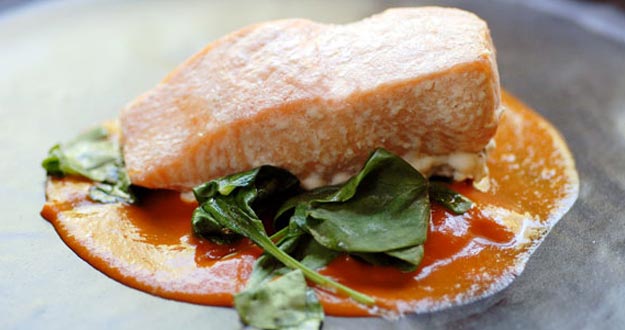
Roasted or cooked salmon is rich in vitamin D
"The data of the article, that we have just published, linked vitamin D deficiency with diabetes, more closely than with obesity, and this finding encouraged to design tests to demonstrate whether vitamin D have a preventive effect", explains Tinahones.
For this study, 118 patients were enrolled and were classified by body mass, index in normal weight, overweight, obese and morbidly obese. In addition, they were subdivided according to their glycemic status in normoglycemic, prediabetic and diabetic.
After comparing the results of the clinical trial, the researchers extracted new data, that conclude that subjects, with diabetes and prediabetes, whether or not obesity, have deficient levels of vitamin D.
Conversely, subjects with obesity and who are metabolically healthy, approximately 20% of obese, have similar levels of vitamin D, to healthy thin.
Vitamin D deficiency is associated with a significantly increased risk of dementia and Alzheimer's disease, and increased risk of developing certain diseases such as cancer, hypertension, cardiovascular disease or multiple sclerosis.
In addition, it has been found that people, who have low levels of vitamin D, are more likely to have diabetes.
Vitamin D deficiency is common, in both obese subjects and patients with diabetes. However the relationship vitamin D, obesity and diabetes had not been tested so far, hence the importance of this research.
What interesting it is!; Is not it?.
Well, until my next post, kind regards,
Luis.
Sponsored by Costaluz Lawyers.
Please click below:

 0
Like
Published at 10:18 AM Comments (0)
0
Like
Published at 10:18 AM Comments (0)
Spanish researchers used iron oxide against atmospheric pollution
Monday, May 25, 2015
I remember when I lived in Madrid --during many years--, which had a lot of pollution, when they had spent many days, with good weather. In those years, there were 4 skyscrapers, that you can see, in the picture, below; but, I do remember the "beret", which set over the city.
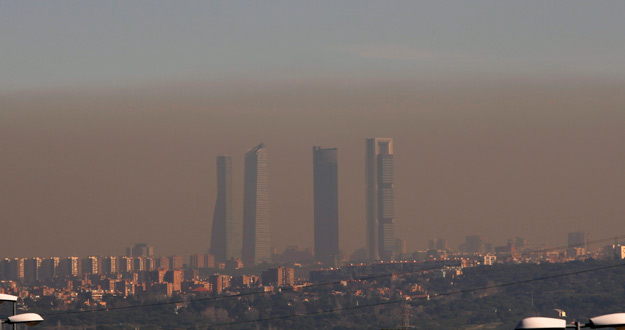
An iron oxide, called hematite, like those that give a characteristic reddish colour, to Mars or River Tinto, has a capacity, that can help to reduce pollution, produced by gases emitted in exhaust and factories.
The compound is capable of reducing the presence of nitrogen oxides, ie, the gases released to air, by combustion and which generate, in the atmosphere, for example, the brownish Beret, that Madrid has, when there is a lot of contamination and a stable weather.
So it has been shown, by researchers from the group of Inorganic Chemistry of the University of Cordoba (South of Spain), who have described a process, that can help create solutions, for this type of air pollution. The details are published, in the journal Applied Catalysis B: Environment.
Nitrogen oxides (NOx, as they are also known) are polluting gases, produced by industry and transport, which can cause respiratory diseases, such as emphysema or bronchitis.
Conventionally, it is generally, to reduce the effects of NOx, into the atmosphere. Even commercial products, using this compound between its components, are marketed; but its price is quite high.
"It is an excellent solution; but the main photocatalytic activity of titanium oxide occurs only with certain conditions of the presence of ultraviolet rays", explains the, Luis Sánchez Granados.
Therefore, this material is useful, in cities with many hours of sunlight, as Madrid or Barcelona; but it is not so, in urban environments, with limited solar incidence or located in northern and central Europe or North America, with more cloudy days and low levels of UVA rays.
In this context, the scientific community has begun a way, to find more efficient alternatives, in recent years. Different compounds are being tested, in laboratories around the world, right now.
In addition to the ability of removing gaseous pollutants, researchers also consider the availability of materials.
In the towns and large cities, are produced the most nitrogen oxides, that pollute air, largely expelled to air from the exhaust pipes of motor vehicles.
Only a large scale will help fight this air pollution. "The iron oxides are abundant, in nature, and they include both environmental and chemical characteristics, that make them attractive, for use as photocatalysts", says Sánchez Granados.
Specifically, the group of UCO has explored capabilities of the hematite, whose formulation is Fe2O3. It is the first time that a scientific team used this material for decontamination of harmful NOx gases.
This iron oxide is quite common, but it can also be found in nature crystallized by complex geological processes, such as forming diamonds.
Hematite gems produced are valued in jewelry. Chemists reproduced some of these processes, in the laboratory, and tested mineral photocatalytic capabilities.
Thus, they could confirm that the hematite was an efficient material, for removing nitrogen oxides air polluting.
The Professor, Luis Sanchez, in order to transfer this new knowledge to industry, has recently presented these results, at the European seminar Ligh2CAT.
At this meeting, held in April, in Valencia, several companies and institutions discussed new to reduce air pollution.
Well, I hope that you think it is as interesting as I did.
Until my next post, kind regards,
Luis.
Sponsored by Costaluz Lawyers.
Please click below:

 0
Like
Published at 10:01 AM Comments (0)
0
Like
Published at 10:01 AM Comments (0)
A Spanish Graduate in Pharmaceutical Sciences gives us some advices to protect our skin fron the sun
Wednesday, May 20, 2015
We have heat, in most of Spain. Feel like going to beach or pool; but it is very important that we protect our skin. Therefore, I would like to show you some advices, which are given us by a lady, Bachelor of Pharmacy, who helps, every day, in the program "The Morning" by TVE. If you want to watch the video, with these advices, please click below:
http://www.rtve.es/alacarta/videos/la-manana/como-elegir-protector-solar/3123027/
Pilar León (Bachelor of Pharmacy.Official College of Pharmacists of Madrid): “How often do you arrive to the shelf, you take a cream, any one, cause of price or whatever ...?, Careful !,we are playing, not only with aesthetic things, but also with health; we are playing with a product, that, if you do not do it well, we can be grossed out, in future. So, I am going to indicate you 3 or 4 steps, that you have to be careful, when you go to take a sunscreen, Right?. For now, always, always ask the person who is there, because it is the best who can indicate you. Why?; it is not the same a redhead person, with green eyes, than a person with brown eyes ..., many times you will get into the mistake: "I have brown eyes, I get burnt a little bit, but then ...", no, no, if you burn a little bit, you have to use a protection factor, which covers you. And how often do we hear, at pharmacies, many times?: "Look, I do not mind, I get burnt a little bit, the first day and the second day and, so, I get dark much earlier", careful!, .... you are burning, causing you these ageing and skin problems. So, what advice I give to you ?. Very simple: look and trust the person, who is indicating you "Take this, take the other". The Doctor told me before, that it is already said: "High Protection and Very High Protection", Right?, and we will not be confused with that. High Protection is 30 and Very High Protection is 50; when do you must give one and when to give another?. Also, look at the "composition and form" formula; Why?, because sun cream, before the cream was given and it was over; but, we are now realising that it is very important: if the cream is well absorbed; if you have some studies that show that the filter lasts more than two hours --not all last longer. As we are putting before the sun, they are being lost--; if the cream has hyaluronic acid and vitamin E –as anti-ageing--. Then, we will see a little bit, look. We have here: the 30, Have we?, We have for face and body, Why?, the face cream is thicker and the body is more fluid; you have it with colored and colorless. We have everything. Here, we have for people who do sport or that bothers you be more sticky, which is a spray, phenomenal absorbed, without problems. Here I brought one .... look it says "water resistance", what does that mean?, it means enduring two hours in the pool. There is another trick that I mean, after two hours, I have to put cream, again; but put good throughout the body. I keep saying tricks. And, finally, finally, the last that are coming, they are, as a fogging formula, which is absorbed, very well, and also has antioxidant. So ...do not take the first ..., pick something that you do well and, indeed, have a good “galenica”(composition and form) formula”.
Mariló (the Presenter of the program “The Morning”): “But above all, I ask you to .... arrive to the pharmacy and say: "According to my skin color, what cream do you recommend me?”. Well, in your case, Mariló, if you told me that you burn the early days, I would not give you 30, in the early days, and that ...... you are brunette, I would give you a 50. it also depends on how long you will be. For example, if you go to Ecuador, I would tell you 50, directly”
Well, I hope this video has been useful for you.
Until my next post, kind regards,
Luis.
Sponsored by Costaluz Lawyers.
Please click below:

 0
Like
Published at 11:00 AM Comments (0)
0
Like
Published at 11:00 AM Comments (0)
Mancerina story, told by a great spanish Explorer
Monday, May 18, 2015
On last April 28, the journalist, Loreto Souto, did an interview on the radio, the Spanish explorer Miguel de la Quadra-Salcedo and Gayarre, at his home in Pozuelo (outside Madrid).
Miguel is Expeditionary, Reporter, Sportsman elite, Qetzal Promoter Route (a project of education and cultural exchange of youth from many countries).
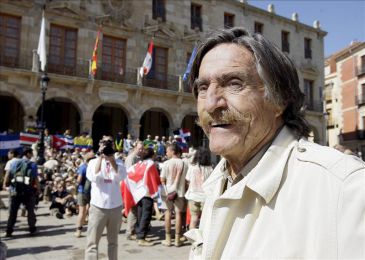
In the garden of his house, Miguel told the following to Loreto:
Miguel: “Good morning, because they are always good. At 7 am, .... hour, you see there, that is dawning, but I drink chocolate and some bread; but rye bread: the bread of truth, there is only in Galice; it there is not in Madrid, then you must bring it from Galice......... And this one, when I arrived, from Peru, it was called "Marquis of Mancera". The Marquis of Mancera, as he was so old, chocolate fell down on the skirts of the ladies; then, he invented this one, that since then it was called "Mancerina", because it was made by the marquis of Mancera."
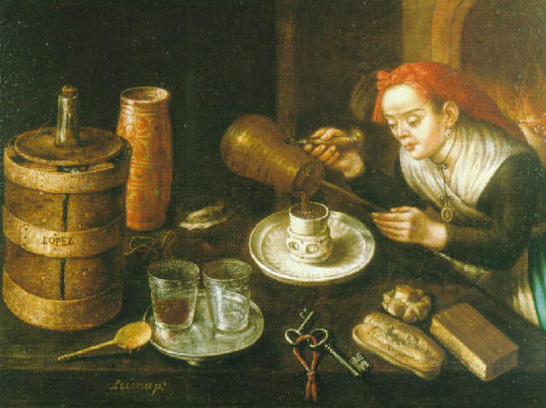
Loreto Souto: "And it is there, where you are going to drink the chocolate."
Miguel: “This was getting here, and in France, which was widely used, too, was called “The A thing that trembles" --because, even shake the cup, chocolate did not fall down--.
Loreto: “It is like a small cup, with the plate incorporated”
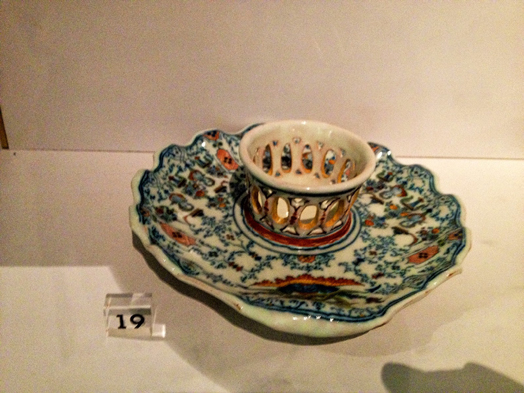
Well, I hope that you have liked to know The Mancerina, in case you did not know it.
Until my next post, kind regards, Luis.
Sponsored by Costaluz Lawyers.
Please click below:

 0
Like
Published at 7:59 PM Comments (0)
0
Like
Published at 7:59 PM Comments (0)
The first Blue Flag, in a river beach in Galice, North West Spain
Friday, May 15, 2015
This year, 2015, in Spain, we have achieved 678 Blue Flags (577 beaches and 101 a marinas. They are 4 beaches more than the last year. And this means that one, in six flags in the world, will flap, in Spain. And also, that, in one in five Spanish beaches, a Blue Flag will flap).
Galice, with 131 awards, to beaches, and 40 coastal municipalities, stands at the head of the autonomous communities, in the number of blue flags, ahead of Valencia (120), Catalonia (89) and Andalusia (78). There are eight more flags, than during the summer of 2014.
The municipality, with more blue flags, is still Sanxenxo (Pontevedra), with 12 beaches, although it has lost two (Caneliñas and Paxariñas). Cangas remains the second municipality, with more accolades, to keep ten achieved, during the summer of 2014. The winners, in this province, also adds Ponte Caldelas, which manages a banner, to the river beach of A Calzada, the first time that a sandy area, of these features, is achieved in Galice. Moreover, Marin added further recognition, to the beach of Santo and add 4.
“A Calzada” is located in the municipality of Ponte Caldelas (Pontevedra, South of Galice).
 Ponte Caldelas Ponte Caldelas
The river beach of Ponte Caldelas is 250 meters long and gets about 250 visitors, a day, on average. It is a bathing area, formed by a stone dam, in riparian forest of birch, chestnut and oak. The quality of these waters was rated, as excellent, in the season 2014.


 a 18,5 cm.jpg)
 a 18,5 cm .jpg)
 a 18,5 cm.jpg)
From the bridge, that crosses the river Verdugo, in Puente Caldelas, leaves a little walk of less than 1 kilometre, along the riverbank, up to the river beach of Puente Caldelas, the first beach of inland waters, in Galice, awarded by the Association for Environmental Education and Consumer (Adeac).

 a 18,5 cm.jpg)
The incorporation of “A Calzada”, to the list of beaches, with Blue Flags, in Galice, is not the only case. In the province of Pontevedra, it is also a novelty the beach of Santo, in Marin. In A Corunia, the beaches: “Meirás-O Rio” (Valdoviño), “Frouxeira”, “Bale”, ”Pantin” and “Villarrube”, next to “Langosteira” (in Finisterre) is new. The new banners, in Lugo, were granted to the sandy areas of Xilloi, in O Vicedo; to the Os Xuncos and As Polas, in Foz; to the lathe, in Cervo; to the Area, in Viveiro.

Beach of Meirás

Beach of Xilloi

Beach of Area
Well, I think this is a good opportunity, in order that you go to Galice, if you do not know it.
Until my next post, kind regards,
Luis.
Sponsored by Costaluz Lawyers.
Please click below:

 1
Like
Published at 9:25 PM Comments (0)
1
Like
Published at 9:25 PM Comments (0)
A Spanish engineer invents an ebook for people with visual disabilities
Thursday, May 14, 2015
I have just found an interesting video, about a very useful invention: an ebook for people with visual disabilities. If you want to watch this video, please click on the link below:
http://www.rtve.es/alacarta/videos/telediario/ebook-para-personas-discapacidad-visual/3106599/
Voice in off: “A trip by bus, inspired him; while reading his eBook, he thought of the options, for the blind, and they did not convince him”.
Carlos Madolell (Creator BRAIBOOK): “The audio book, you can not connect both with the book, as if what you read it, and Braille lines, conventional, are very large and very expensive”
Voice in off: “He has invented a small device, that transforms documents, into different formats and languages, to the Braille System”.
Carlos Madolell: “We are going to give the reader a new experience, making the text goes through screen. This means that the blind will only have to put its finger, on the screen, and get to read”
Aina Galduf (Voice in off. Editorial office Catalonia): “It measures less than 10 centimetres; but it allows the reader to have a whole library, close at hand. Now, it is only a prototype; but the final one will be released, at the end of the year”
Voice in off: “It incorporates a very comfortable reading system”
Manel Martí (President Visual Disabilities Association Catalonia): “Portability is the attractive thing: that you can take it, over the world, without bothering you, absolutely, this facilitates the communication of the blind and people with low vision.”
Voice in off: “And three hours, of battery life, so they can also enjoy and feel the pleasure of reading”.
Once again, it is shown that, in Spain, there are very creative, very prepared --at scientific level-- and with a great heart, to put their knowledge at the service of others.
Until my next post, kind regards,
Luis.
Sponsored by Costaluz Lawyers.
Please click below:

 0
Like
Published at 11:26 AM Comments (0)
0
Like
Published at 11:26 AM Comments (0)
Reappears a picture not located at the Prado Museum, Spain
Wednesday, May 13, 2015
I have just found an interesting news, that I would like to share with you. This article reads as follows: The Prado placed one of its paintings "unlocated".
Yesterday, The Prado Museum has recovered a painting, as shown, on its inventory, as "not localized", one representing the Queen Maria Cristina de Borbon, by Luis de la Cruz and Rios, and that was in a private collection, the art gallery has been reported, in a note.

The Queen Maria Cristina de Borbón
The work, which has been delivered, to the Prado, yesterday, by its current owner, Manuel Linares, is registered, as an anonymous author, in the inventory of paintings from the Spanish Royal Collection, published in 1990, with the number 2796 of seat, a figure that is painted in red, on the lower left corner of the canvas.
After a restoration, commissioned by the current holder of the piece, it appeared the signature of the author, Luis de la Cruz and Rios, who was called the Canarian, for being a native from the Puerto de la Cruz, Tenerife (Canary Islands).

The Director of El Prado, Miguel Zugaza,beside the work and who was its owner, Manuel Linares
This painting, filed in 1908 by the Prado, in the then Ministry of Governance, "was acquired in good faith, in October 1967, by Manuel Linares Barrero, to the National Delegation of Social Aid, with several pieces of furniture, one carpet, other 6 paintings and 2 trucks of scrap", explains, in its note, the museum. "Hence, in the different revisions, made since 1978, has not been located, in its storage place", it adds.
Luis de la Cruz and Rios (Puerto de la Cruz, 1776 - Antequera, 1853) was the son of a woodcarver, estofador (a man who applies a technique of polychrome wood) and painter, and made his studies, at La Laguna, where he would be, years later, a teacher, at its School of Drawing. He was appointed Mayor of his hometown, in 1807, and, eight years later, he traveled to Madrid and, being a supporter of the King Ferdinand VII, he managed to portray the monarch, who granted the honors painter, the following year.
He made numerous portraits of various members of the royal family, and he specialized, in making miniatures, activity for which he is best known and which can be seen an autograph example, in the “room 100” of the building Villanueva, next to the Treasure of the Dolphin.
After several years of research work and inventorying, the Prado has already located 860 records, which, cause of loan or poor inventorying, are out of its control.
After this "discovery", they would still are 884, --corresponding 748 to works from the Museum of the Trinity and the Museum of Modern Art--. In 1872, the collections of the Museum of the Trinity were attached to the Prado and, many of them, were "scattered", without "even" to effectively enter the collections of the Prado, as explained by this art gallery.
Alongside these works, the public prosecutor´s office report identified another group, corresponding to deposits (temporary or indefinite transfer to other entities), previously made by the defunct Museum of Modern Art, whose collections, of the nineteenth century, were also ascribed to the Prado, in 1971.
The Prado, which has 3,310 works, deposited in 278 institutions, has always had a policy of not terminate any work, since there is no evidence of its destruction or ultimate demise.
Did you know that restaurateurs do not leave their perfect works?. I did not know it, until a friend of mine, painter and restorer, said it to me; he explained me that restaurateurs do not complete restoration and not leave, for example a painting, perfect, so you know this picture is restored. Curious, right ?.
Well, I think it is very important that the owner of that portrait of the Queen Maria Cristina of Borbón has given this painting to the Prado Museum. I hope that you can go, to Madrid, in order to see this portrait and another paintings.
Until my next post, kind regards,
Luis.
Sponsored by Costaluz Lawyers.
Please click below:

 0
Like
Published at 6:34 PM Comments (0)
0
Like
Published at 6:34 PM Comments (0)
Light, colour and ferocity, in southern Spain
Monday, May 11, 2015
The day before yesterday, a brother of mine sent me some pictures, which he had done, a few days ago, near Zahara de los Atunes (Cádiz, Southwest Spain), where he passed by a cattle farm, called "TAPATANA".
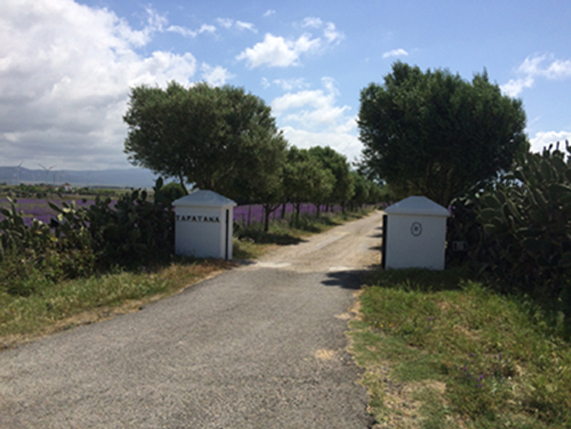
The owner of this property is Maria Dess Allymes, along with her five children (Ana, Javier, Ignacio, Jose Luis and Carlos Nuñez –got married to Inés Parias--).
The first wonder, seen by my brother, was a beautiful field with lavender flowers……
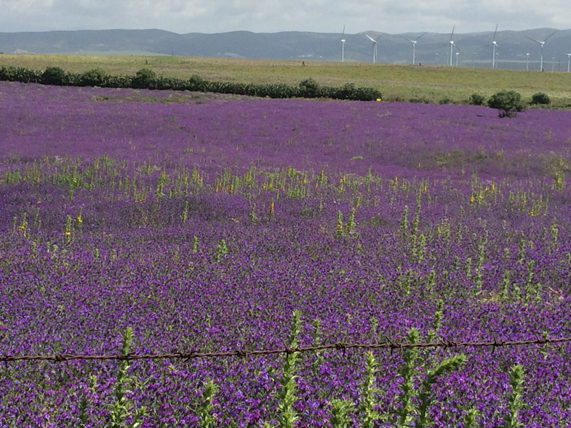
In this magnificent cattle farm, are grazing the cattle of fierce bulls "Carlos Nuñez".
Carlos Nuñez, as a cattle breeder, has maintained the style of his grandfather --also Carlos Nuñez--, who highlighted, as a cattle, in the early twentieth century, and it never mixed the blood of their cows with bulls of other farms.
My brother could be relatively close to some bulls.

Upon entering, you can see the door of the house (typical Andalusian farmhouse, named Cortijo). This house was built by the architect from Jerez, Miguel Revuelta, under the guidance of the five brothers and modeled after Andalusian cortijo, where the white lime and Arab tile predominate.
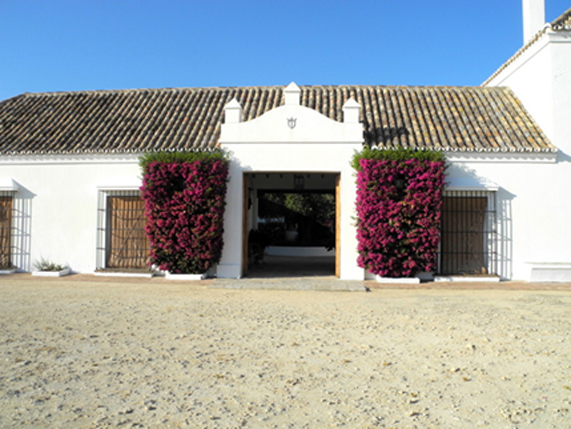
Inside, you can enjoy a very nice andalusian patio:

And you can see a comfortable living-room:
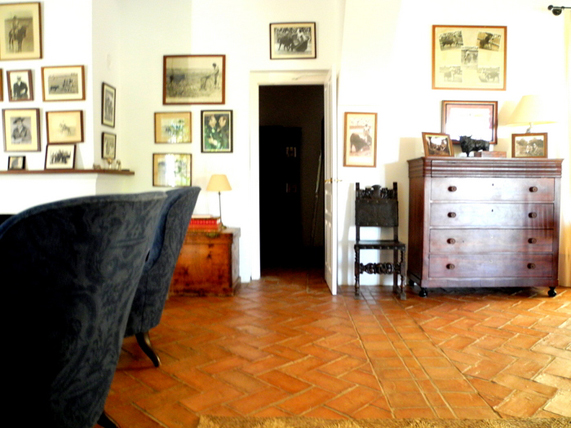
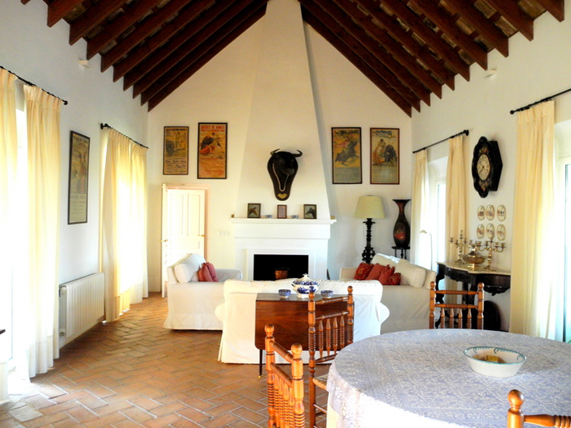
The porch:
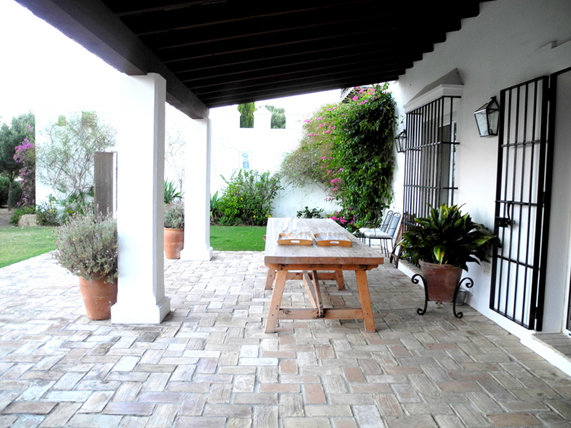
The children playing in the garden:
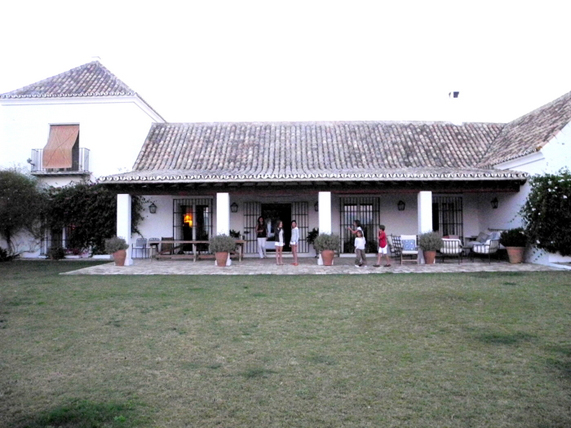
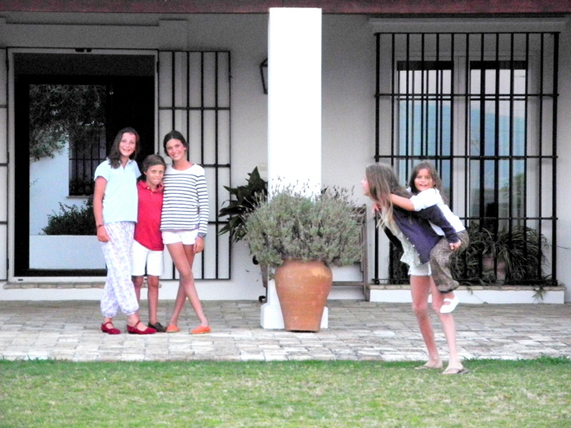
Here, you can see Inés (the Carlos Nuñez´s wife), with two daughters:
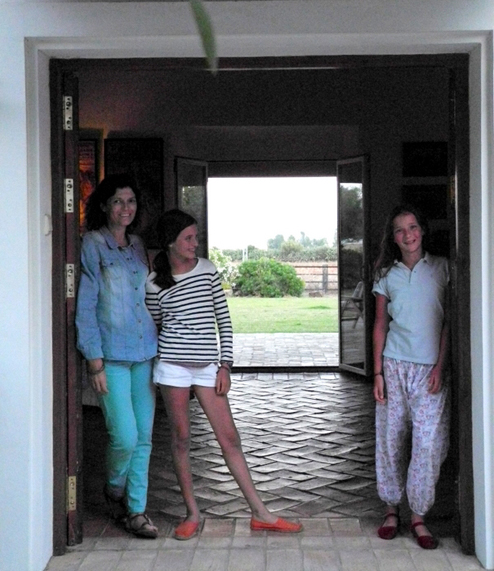
Straw hat typical for field:
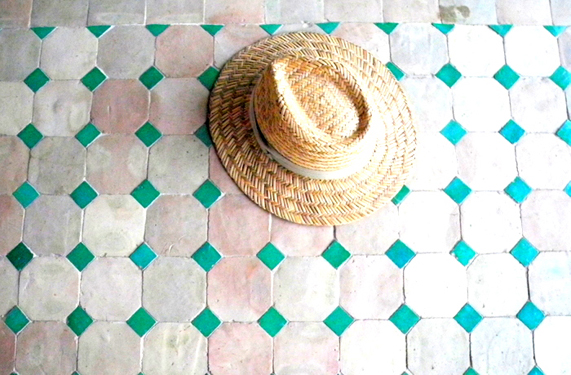
Here, you can see Inés, with a sister of her. They say that their mother (Maria Luisa Halcón Álvarez Osorio), was chosen "Ideal woman", in Europe, in 1967. And, that same year, she starred, in the cover of the magazine Telva. The truth is that she was a beautiful and elegant lady.
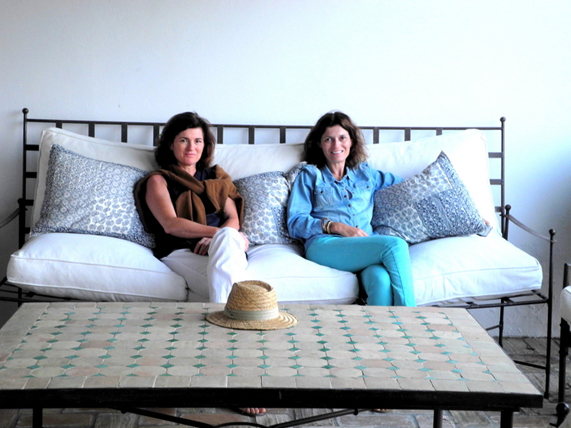

Now, you can see the small bullring and Carlos Nuñez, fighting a heifer:
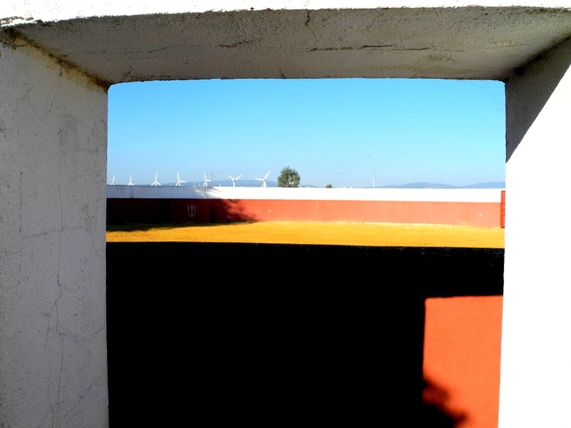
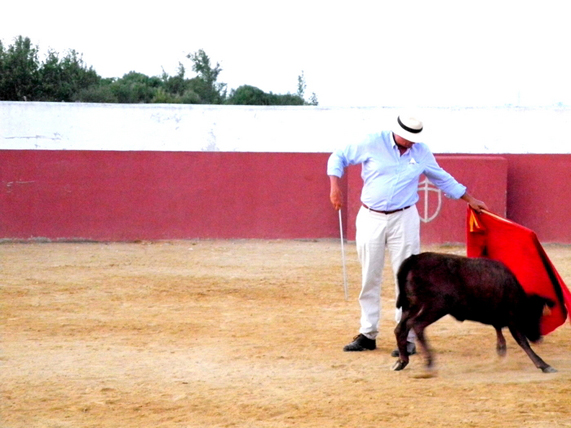
Well, I hope that you have liked to know about this cattle farm and I also hope that you can come here, to see this field and around.
Until my next post, kind regards,
Luis.
Sponsored by Costaluz Lawyers.
Please click below:

 0
Like
Published at 7:52 PM Comments (0)
0
Like
Published at 7:52 PM Comments (0)
A Spanish doctor gives us some advices to improve our circulation
Friday, May 8, 2015
I found an interesting video, where a Spanish doctor, Ana Bellon, speaks of certain foods, which help us to improve our blood circulation. If you want to see the video, please click on the link below:
http://www.rtve.es/alacarta/videos/la-manana/alimentos-buenos-para-mejorar-circulacion/3104577/
Ana Bellón (A doctor in TVE): “Then, we are going to try to make the patient lose weight, because the fact that we catch weight makes venous circulation is more difficult; but, now, we are going to focus ... I am going to tell you the botanical name: "Solanum Melongena" ...
Mariló Montero (the Presenter of the program “La mañana”): “I am all morning……Solanum…
Ana Bellón: “Melongena…”
Mariló: “Melongena”
Ana: “And you will say: “What is that?”. Well, but it is…this one: aubergine; but I was telling you the botanical name. There are many studies done on aubergine and, in fact, have been found more than 115 compounds, beneficial to our health, and parts of the plant have been tested; but, really, where there are more compounds is in the fruit, which is really what we eat. Not only we look at its purple colour, that is provided by the Anthocyanins (a major antioxidant there is); but, in addition, it is low in calories, has minerals, has vitamins and generally, it has been shown that is good for the circulation of the legs or, in general, circulation, because also among other things, for example, it lowers cholesterol. But, for example, in spices, we have cinnamon; cinnamon, both branch and ground, has been shown to have properties, for good circulation, because it is antiplatelet, antithrombotic and antisclerotic; ie, it prevents blood clots, prevents the formation of thrombi or even sclerosis, atherosclerosis, within the arteries. And finally, we look at oranges; oranges, really, we could say that, like aubergine, is a star food, for our circulation: first, because they are rich in Vitamin C; Vitamin C facilitates the formation of collagen. Inside the mineral, it is potassium, and potassium helps eliminate fluids. It is rich in fiber and prevents constipation and, if you look at the white part, it is very rich in routine and piperidine (flavonoids, which make our veins become more strong and therefore not dilate). So, between Solanum melongena, Cinnamon and Orange, we have solved it, Mariló.”
Well, I think it is very important to follow those advices, because, at the end, we all suffer the consequences of a poor circulation, for example in our legs. Above all, this happens when our age increases.
Until my next post, kind regards,
Luis.
Sponsored by Costaluzlawyers.es.
Please click below:

 0
Like
Published at 6:05 PM Comments (0)
0
Like
Published at 6:05 PM Comments (0)
Discovered in Spain a drug for leukemia that slows down the cancer of pancreas
Thursday, May 7, 2015
Some weeks ago, I found an interesting news, that I should like to share with you today: “A drug for leukemia slows down pancreatic cancer in a test on mice”.
A drug, used in some leukemias and lymphomas, has proved effective in slowing the growth of pancreatic cancer. This has been demonstrated, in a preclinical assay on mice, that has been conducted by the Vall d'Hebron Institute of Oncology (VHIO), in Catalonia, North east of Spain.

3D illustration of a man´s pancreas
Researchers from the Modelling group antitumor therapies on mouse, at the VHIO, have demonstrated the utility of a drug, inhibitor of BTK kinase, called Ibrutinib, to treat pancreatic cancer, in preclinical models on mice. The research has been published, in the journal Cancer Research.
The oncologist, who led the research, Laura Soucek, believes that the Ibrutinib opens the door to a new therapeutic approach, for other fibrotic diseases.
The Soucek´s group has studied, in recent years, the importance of cells, called “mastocitos”(“mast cells”), in some tumors, and the Ibrutinib is essential, in turn, to activate the mast cells.
The drug inhibits the enzyme Bruton's Tyrosine Kinase (BTK, for its acronym in English), necessary for the maturation of cells involved in certain hematologic cancers.
This led them to test the drug, first, with the aim of inhibiting mast cells, in a model of insulinoma on mice.
The results were very positive, so the researchers decided to try it also, in models of pancreatic adenocarcinoma, the most common and aggressive tumor of pancreas, which has a remarkable infiltration of mast cells and a high rate of growth and spread.
Some patients, affected by this disease, with poor response to treatment and, therefore, a very low survival.
“The results were conclusive and growth of tumors, in animals, slowed", said Daniel Masso, one of the researchers on the project.
The doctors tested administered the Ibrutinib, as monotherapy and in combination with standard chemotherapy, in tumors of the pancreas, and in both cases improved survival of mice.
"Pancreatic tumors are characterized by be interspersed, with a dense stroma (the extracellular matrix of an organ) fibroinflammatory. A kind of ball of fibroblasts and collagen, that makes like a capsule effect, which hinders the arrival of chemotherapeutic drugs to the heart of tumor effectively”, said Masso, ie, the drug handles weaken the capsule and it helps chemotherapy to act.
The test with mice has shown that the Ibrutinib "reduces this stroma evidently. Our hypothesis is that this is the mechanism, by which this drug, associated with standard chemotherapy, improves survival", the researcher has materialized.
Despite these encouraging results are still preclinical and have been obtained using mice, the fact that pancreatic tumors are aggressive, combined with the lack of therapeutic options, and that it is already an existing drug, approved for use in other cancers, opens the door to its applicability, in patients with pancreatic cancer.
"Between a scientific discovery and its clinical application, usually takes years. In this case, since the efficacy and safety of this drug is already known and has been approved for other types of tumors, it is reasonable to expect that, quickly, are launched clinical trials to validate the use of Ibrutinib, for pancreatic cancer", concluded Laura Soucek.
According to the director of the research, this finding opens the door to Ibrutinib therapy can also be considered as a treatment option, for fibrotic diseases, such as pancreatitis or hepatic fibrosis.
Well, I see it very important that the drug is already known. But we have to wait for the clinical trials. I hope this discovery become to help patients very soon.
Until my next post, kind regards,
Luis.
Sponsored by Costaluz Lawyers.
Please click below:

 0
Like
Published at 4:09 PM Comments (0)
0
Like
Published at 4:09 PM Comments (0)
A Path of perfection in Spain
Tuesday, May 5, 2015
I have found a video, about one of the books, wrotten by Santa Teresa, tittled “Camino de perfección” (“Path of perfection”). If you want to watch this video, in order to know more about that book, please click on the link below:
http://www.rtve.es/alacarta/videos/telediario/camino-perfeccion-santa-teresa-se-incorpora-muestra-bne/3107624/
Voice in off: “It has arrived, in a special bag, from the Convent of the Discalced Carmelites of Valladolid, who guard him for almost five centuries. Rarely it has left the closing, because of its enormous value; but the Exhibition, which is dedicated to Santa Teresa, at the National Library on the occasion of the fifth centenary of her birth, is one of those special occasions.”.
Juan Dobado (Curator of the Exhibition): “Its state of preservation is superb, because, well, it is a codex, which is differentiated, from the other version of the Escorial Monastery, because it is already drafted as a treaty; ie, she is dividing the chapters, she makes the drafting, and the book of "path" is like a catechesis of what being Discalced Carmelite”
Amaia Pérez de Mendiola (Voice in off): “Read, with eyes from today, Santa Teresa is surprisingly modern. A senior leader of the Church, of that time, came to describe her as "female, restless and wandering", adjectives that, surely, then were more than thick”.
Juan Dobado: “Her reflections, her writing seems to us totally current; ie, Why?, because she is a fighter, an enterprising…”
Now, you can read: TERESA DE JESUS. FROM APRIL 27 UNTIL MAY 31, THE SECOND MANUSCRIPT OF “PATH OF PERFECTION” IS EXPOSED.
Amaia Pérez de Mendiola: “Sculptures, polychrome, by Gregorio Fernandez and paintings by Rivera and Rubens ..., books, letters written, in her own handwriting, or her personal breviary: 110 pieces of immense value; so that, for conservation reasons, they can only be exposed for a month”.
Well, I think it is very interesting the opportunity of seeing this Exhibition. I hope that you can visit it.
And I also think that it is very interesting to know that Santa Teresa was a very persistent woman, because that certainly encouraged many women to get many challenges.
Until my next post, kind regards,
Luis.
Sponsored by Costaluz Lawyers.
Please click below:

 0
Like
Published at 7:11 PM Comments (0)
0
Like
Published at 7:11 PM Comments (0)
The hobby for cycling in Spain can revolutionize our economy
Monday, May 4, 2015
Some days ago, I found a news, that I did not know: “Bike power to revolutionize the economy”. I have liked this news, because, some days ago, a friend of mine, who lives in Madrid, told me about the benefits of an electric bicycle.
Effectively, bike offers great business opportunities, from touring by bicycle to transport of merchandise by cargo tricycles and it has been even created an interparliamentary group to promote it. This is a booming sector with great potential. In Spain more bicycles than cars are sold and, more than 36,600 new jobs, could be created, if its use, as a means of transportation, will be double.

A young woman is going to her job by an electric bicycle
Two weekends ago, in Madrid, was held the first fair of entrepreneurs Bicity.org, an event which has hosted projects to promote the use of bicycles, in cities, beyond municipal rental services. The winner was Pablo Rosa, with Don Cicleto, a network of bicycle racks, in Madrid, to store the bike safely.
Rosa explained, to RTVE.es, he believes his idea will succeed, because "it resolves concerns, about theft of bikes and gives added services, such as maintenance or a map, with a network of friendly spaces for cyclists.". His company is launched, in April, with 12 parking spaces, that offer 250 placements and once entrenched, in the capital, is raised expand to other cities.
Ciclogreen, by Gregorio Magno, has been in second place. It uses mobile applications, that measure kilometers, traveled by bike, and rewards users with items or discounts. Companies also can use their services and register reductions, in carbon emissions, when workers go to work by bike.
European bicycle manufacturers, grouped in the Cycling Industry Club (CIC), are driving a green job initiative, to create 200,000 new jobs, related to cycling. According to their calculations, if the number of cyclists is doubled, in Europe, they could sell "10 million bicycles more each year" and, if the use of the bike reached, in each country, at the level of Netherlands (18 million bikes and 16 million people), "annual sales could grow to 30 million units.".
Spain could generate 36,603 new jobs in the sector, of which the majority (28 937) would be generated, in the cycling industry, if the rate of use of the bike, on commuting, was doubled according to the European Cyclists' Federation. The study, published in December, also shows that jobs, in cycling routes, accommodations adapted for cyclists, maintenance, security, accessories, mobile applications or specialty shops are more stable and accessible to people without much qualification.
The Federation calls for 10% of transport budgets, to encourage the use of bicycle is intended and argues that most jobs related to bike "neither they can be offshored outside our borders, nor even be transferred from their local area.".
The National Bureau of the Bicycle argues that Spain must attract more tourists by bike. The turnover of the European touring by bicycle is 43,940 million, of which 1,620 million correspond to Spain, a figure that could grow exponentially, considering that France more than quadrupled to 7,490 million, says, to RTVE.es, the expert on tourism by bike, Xandra Trojan.
The author of the study, on the economic impact of touring by bicycle, in Europe, underlines the great potential in Spain, a subject that our country does not approve, despite having diversified tourism. Trojan notes that "the economic weight of the bike is well above the public effort required" and she cites that, in France, "every euro invested, in supporting bicycle, is multiplied by nine”.
The profile of a touring cyclist is not a young with a few money, who travels by bike, because it has no other options. Rather, it is a university, between 45 and 55 years, with good social status. 60% are men and 40% women, they use to travel more than a week and they spend on average 439 euros. A day, they spend between 50 and 70 euros, including accommodation, details the expert.
"The touring by bicycle is based on simple infrastructure, easily redeemable, but require planning, maintenance and consistent and coordinated development", said Trojan. In Spain, greenways represent 2,000 kilometers, but they are not interconnected among themselves. Mostly are located in Andalusia (425 kilometers), but lack a national plan to achieve results.
France is the perfect example: "It started to invest in touring by bicycle later to Spain; but, now, is the premier destination for tour operators, followed by Austria". Trojan down as keys to success "the attractive offer of 7,000 km, of greenways and cycle routes, on one hand, and the policy, in favor of cycling, with an inter-ministerial coordinator, Monsieur Vélo".
In the last two years, they have been sold more bicycles than cars and all-terrains, for the first time, in Spain. In 2013, 1.034.000 bikes were purchased, for 722 703 cars and the trend continues, in 2014. The number of bicycles sold, largely will exceed one million units, according to the sources from the Association of Trademarks and Bicycles of Spain (AMBE) have advanced to RTVE.es.
By type of bike, the best sellers are still the mountain bikes, but electric bikes experienced "an strong double-digit growth and some companies of the sector have increased their sales, by up to 30%, driven by the PIMA plan", according to sources from AMBE.
The option of bicycle, as efficient transport within cities, has become deeply ingrained, even among automakers. Ford has presented, at the Barcelona Mobile Congress, a project that includes a folding electric bike, that can be carried in the car. The company proposes to leave the vehicle, parked on the outskirts of the city, move by public transport and arrive to work, by bike.
Bicycle also offers innovative solutions, for last-mile distribution, ie, in the distribution of goods within cities. Txita is a company, from San Sebastian, leading in logistic by bike, a field to which 67 companies are dedicated, in all Spain. Its founder, Daniel Ruiz, got the third prize Bicity.org, with a project of a sectorial association.
Ruiz explained, to RTVE.es, that the key to survival is to be adapted and diversify the activity. Originally, in 2006, they were dedicated only to pedicabs; the vehicle served as an advertising support and drivers all the money pocketed journeys. Three years later, the economic crisis became an almost impossible mission, to find advertisers and business resented, because "in winter, there were no tourists and no travel".
Txita founder realised, that he needed to expand services and now he works for companies such as Seur, Eroski or Gupost. In addition to having met with Post, which has been asked a budget, to deliver, by bike, through San Sebastian.
At present, the distribution of goods, in the centre of Donosti, "accounts for 40% of business of Txita, 30% comes from the distribution and sale of electric delivery tricycles, 20% of advertising campaigns (in pedicabs) and 10% in other activities, from consulting services to the mobile tannoy, with a DJ on board of a tricycle", explains Ruiz.
This entrepreneur sees only an obstacle, to the expansion of his business, the traffic code, which limits the engine power of electric bicycles to 250 watts. He suggests that expands up to 500 watts, to climb steep slopes, with a loaded tricycle.
Daniel Ruiz believes that "the distribution, in urban areas, with cargo tricycles, is where there is more future", by traffic restrictions, in urban centres, rising gasoline and increased hours of autonomous, dedicated to conventional transport.
When the founder of Txita explains, to the big logistics companies, that their electric tricycles can charge 250 kilograms and move around the pedestrian streets, they tell him that their activity is the future; but Ruiz answers that "it is present" and he is convinced that 2015 "It will be the year of the emergence of cargo tricycles.".
I think that, now, Spain has a great chance, to be one of the countries with most touring by bike; but, for that, we should have to make more bicycle advertising, for example on television, radio and, even, in newspapers. Also, we should expand the network of greenways and that they were interconnected.
I hope that Spain has the advantage of creating many jobs through touring by bike.
Until my next post, kind regards,
Luis.
Sponsored by Costaluz Lawyers.
Please click below:

 0
Like
Published at 11:06 AM Comments (0)
0
Like
Published at 11:06 AM Comments (0)
Spam post or Abuse? Please let us know
|
|